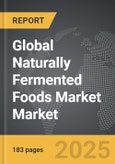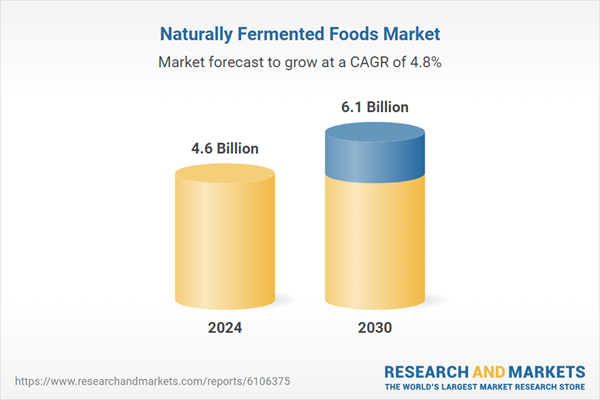Global Naturally Fermented Foods Market - Key Trends & Drivers Summarized
Why Are Naturally Fermented Foods Gaining Popularity Across Global Diets?
Naturally fermented foods are becoming more prominent in modern dietary habits due to growing consumer awareness of digestive health, immune function, and food authenticity. These products undergo spontaneous or controlled microbial fermentation, often involving lactic acid bacteria, yeasts, or beneficial fungi. Examples include yogurt, kimchi, sauerkraut, miso, kombucha, kefir, tempeh, and pickled vegetables. Unlike processed alternatives, naturally fermented foods often contain live cultures, offering both taste and health benefits.The revival of traditional diets and increasing interest in gut microbiota have positioned fermented foods as functional staples in health-conscious eating. Consumers associate fermentation with minimal processing, natural preservation, and enhanced nutritional value. These foods offer complex flavors, extended shelf life, and reduced need for artificial additives, aligning with clean-label and sustainable food trends. Their integration into both mainstream and specialty diets is expanding rapidly, from Western health stores to traditional Asian and Mediterranean culinary settings.
How Are Product Innovations and Processing Techniques Evolving?
Artisanal and commercial producers are refining fermentation techniques to improve consistency, safety, and flavor profiles. Controlled fermentation using starter cultures allows for standardized quality and microbial composition while preserving traditional characteristics. Cold chain logistics and small-batch fermentation systems help retain live probiotics and prevent over-fermentation or spoilage. Some brands now pair traditional fermentation with modern food safety testing to meet regulatory requirements and consumer trust expectations.Product development is also expanding beyond conventional categories. Fermented beverages now include fruit-based tonics, herbal blends, and plant-based kefirs. Non-dairy yogurt made from oats, almonds, or soy is being fermented using strains that support similar texture and probiotic effects. Savory fermented snacks, condiments, and sauces are being introduced to meet demand for innovative flavors with functional appeal. This evolution of formats supports consumption across different meal occasions and dietary preferences.
Which Regional Markets and Demographics Are Driving Demand?
Demand is growing across both traditional and emerging markets. In Asia, fermented foods remain dietary staples, while in North America and Europe, they are increasingly associated with wellness and culinary exploration. Younger consumers, including millennials and Gen Z, are showing strong interest in fermented foods as part of gut-friendly, vegan, or whole-food diets. Health-conscious segments and those seeking natural immune support are particularly drawn to fermented beverages, dairy alternatives, and fermented condiments.Urban populations and premium health food retailers are influencing trends by stocking specialty fermented items and promoting education around probiotics and fermentation benefits. Online grocery platforms and subscription services are also expanding availability of niche fermented products. In rural and low-resource settings, fermentation remains a vital technique for food preservation, aligning with food security and sustainability efforts. This dual demand from both modern and traditional consumer bases continues to broaden market appeal.
Growth in the Naturally Fermented Foods Market Is Driven by Several Factors…
Growth in the naturally fermented foods market is driven by several factors. Increasing awareness of gut health and microbiome diversity supports inclusion of live-culture products in daily diets. Demand for clean-label, minimally processed, and preservative-free foods fuels interest in traditional fermentation methods. Expansion of plant-based and dairy-free product lines creates new opportunities for innovation. Advances in microbial research and starter culture development enhance consistency and product safety. Retailers and foodservice operators are integrating fermented items into mainstream offerings. Finally, cultural rediscovery of ancestral food techniques combined with modern health trends continues to reinforce market momentum.Report Scope
The report analyzes the Naturally Fermented Foods market, presented in terms of market value (US$). The analysis covers the key segments and geographic regions outlined below:- Segments: Product Type (Dairy Products, Bakery Products, Other Product Types).
- Geographic Regions/Countries: World; United States; Canada; Japan; China; Europe (France; Germany; Italy; United Kingdom; Spain; Russia; and Rest of Europe); Asia-Pacific (Australia; India; South Korea; and Rest of Asia-Pacific); Latin America (Argentina; Brazil; Mexico; and Rest of Latin America); Middle East (Iran; Israel; Saudi Arabia; United Arab Emirates; and Rest of Middle East); and Africa.
Key Insights:
- Market Growth: Understand the significant growth trajectory of the Dairy Products segment, which is expected to reach US$3.6 Billion by 2030 with a CAGR of a 4.1%. The Bakery Products segment is also set to grow at 5.6% CAGR over the analysis period.
- Regional Analysis: Gain insights into the U.S. market, valued at $1.2 Billion in 2024, and China, forecasted to grow at an impressive 7.5% CAGR to reach $1.2 Billion by 2030. Discover growth trends in other key regions, including Japan, Canada, Germany, and the Asia-Pacific.
Why You Should Buy This Report:
- Detailed Market Analysis: Access a thorough analysis of the Global Naturally Fermented Foods Market, covering all major geographic regions and market segments.
- Competitive Insights: Get an overview of the competitive landscape, including the market presence of major players across different geographies.
- Future Trends and Drivers: Understand the key trends and drivers shaping the future of the Global Naturally Fermented Foods Market.
- Actionable Insights: Benefit from actionable insights that can help you identify new revenue opportunities and make strategic business decisions.
Key Questions Answered:
- How is the Global Naturally Fermented Foods Market expected to evolve by 2030?
- What are the main drivers and restraints affecting the market?
- Which market segments will grow the most over the forecast period?
- How will market shares for different regions and segments change by 2030?
- Who are the leading players in the market, and what are their prospects?
Report Features:
- Comprehensive Market Data: Independent analysis of annual sales and market forecasts in US$ Million from 2024 to 2030.
- In-Depth Regional Analysis: Detailed insights into key markets, including the U.S., China, Japan, Canada, Europe, Asia-Pacific, Latin America, Middle East, and Africa.
- Company Profiles: Coverage of players such as Anhui Chengya, AVMACOL Corporation, Bioriginal Food & Science Corp., Brassica Protection Products, CS Health and more.
- Complimentary Updates: Receive free report updates for one year to keep you informed of the latest market developments.
Some of the 42 companies featured in this Naturally Fermented Foods market report include:
- Anheuser-Busch InBev
- Cargill, Inc.
- Chobani LLC
- Conagra Brands, Inc.
- Danone S.A.
- Fonterra Co-operative Group
- FrieslandCampina
- General Mills, Inc.
- GT’s Living Foods
- Hain Celestial Group, Inc.
- KeVita (PepsiCo)
- Kraft Heinz Company
- Lifeway Foods, Inc.
- Mondelez International
- Nestlé S.A.
- PepsiCo, Inc.
- Pulmuone Co., Ltd.
- Sahmyook Foods
- Unilever PLC
- Yakult Honsha Co., Ltd.
This edition integrates the latest global trade and economic shifts into comprehensive market analysis. Key updates include:
- Tariff and Trade Impact: Insights into global tariff negotiations across 180+ countries, with analysis of supply chain turbulence, sourcing disruptions, and geographic realignment. Special focus on 2025 as a pivotal year for trade tensions, including updated perspectives on the Trump-era tariffs.
- Adjusted Forecasts and Analytics: Revised global and regional market forecasts through 2030, incorporating tariff effects, economic uncertainty, and structural changes in globalization. Includes historical analysis from 2015 to 2023.
- Strategic Market Dynamics: Evaluation of revised market prospects, regional outlooks, and key economic indicators such as population and urbanization trends.
- Innovation & Technology Trends: Latest developments in product and process innovation, emerging technologies, and key industry drivers shaping the competitive landscape.
- Competitive Intelligence: Updated global market share estimates for 2025, competitive positioning of major players (Strong/Active/Niche/Trivial), and refined focus on leading global brands and core players.
- Expert Insight & Commentary: Strategic analysis from economists, trade experts, and domain specialists to contextualize market shifts and identify emerging opportunities.
Table of Contents
Companies Mentioned (Partial List)
A selection of companies mentioned in this report includes, but is not limited to:
- Anheuser-Busch InBev
- Cargill, Inc.
- Chobani LLC
- Conagra Brands, Inc.
- Danone S.A.
- Fonterra Co-operative Group
- FrieslandCampina
- General Mills, Inc.
- GT’s Living Foods
- Hain Celestial Group, Inc.
- KeVita (PepsiCo)
- Kraft Heinz Company
- Lifeway Foods, Inc.
- Mondelez International
- Nestlé S.A.
- PepsiCo, Inc.
- Pulmuone Co., Ltd.
- Sahmyook Foods
- Unilever PLC
- Yakult Honsha Co., Ltd.
Table Information
| Report Attribute | Details |
|---|---|
| No. of Pages | 183 |
| Published | November 2025 |
| Forecast Period | 2024 - 2030 |
| Estimated Market Value ( USD | $ 4.6 Billion |
| Forecasted Market Value ( USD | $ 6.1 Billion |
| Compound Annual Growth Rate | 4.8% |
| Regions Covered | Global |









